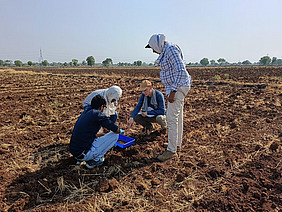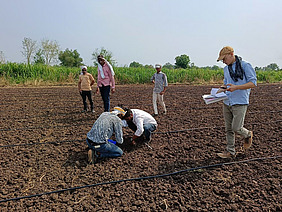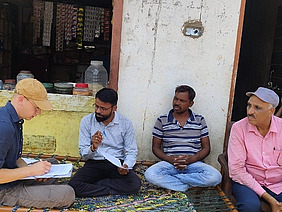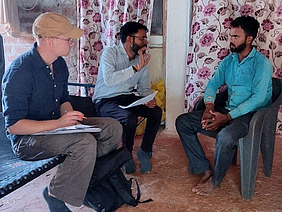Welcome back to Switzerland. You did your bachelor's thesis as part of the SysCom project. What is it about, and how did you get involved?
Andrin Schilliger: The SysCom project has been running since 2007 and investigates the potential of organic farming in the tropics compared to conventional systems. The project has long-term trials in India, Bolivia and Kenya, with the DOK trial in Switzerland serving as an example. My agronomy degree program with a major in international agriculture includes a six-month internship abroad. So, I went to India and was able to combine it with my bachelor's thesis. My work focused on on-farm research, in which we worked together with local farmers (only men, since they usually run the farms, editor's note) on innovations for sustainable production.
What motivated you to focus on the topic of soil fertility in cotton farming in India?
I am very passionate about organic farming and soil fertility. In India, cotton yields are often low and highly variable. We wanted to find out how the farms' soil fertility management affects soil fertility and how this in turn affects the growth of the cotton.
What are the common methods used by farmers to improve soil fertility in the region you visited?
Farmers use a range of practices, including farmyard manure (cattle dung), compost and, to a lesser extent, green manures and crop rotation. Most farmers keep their own animals and use their dung as fertiliser. Other fertilisers such as rock phosphate were used only rarely and in smaller quantities. About a third of the farmers surveyed also used compost, and a few used green manures or incorporated crop residues into the soil to increase soil fertility, although this often competed with animal feed.
What did a typical working day in India look like for you?
A typical working day consisted of contacting farmers, fieldwork to collect samples and conduct interviews, and data entry and analysis. Working with the local team was very positive, thanks in part to the professional and experienced team on the ground. During the interviews, a translator who spoke both English and the local dialect helped to overcome language barriers.
The campus is located in Madhya Pradesh, south of the city of Indore, in a very rural and quiet area. How did you spend your free time?
There was indeed not much happening there. Sometimes I rode my motorbike to a nearby town to buy fruits, went for a walk in the fields or had Hindi lessons. At the weekend, I would accompany my colleagues to go swimming in the river or visit a temple.
Can you tell us more about your research methods? How did you collect the data to answer your questions?
We conducted interviews with about 40 farmers and took soil samples that were analysed in the laboratory (and measured the growth of the cotton plants). The interviews focused on soil fertility management, crop rotation, fertiliser use and crop residue management, among other topics. We also collected socioeconomic factors such as farm size, duration of organic management and farmers' education levels to get a comprehensive picture.
What were the key findings of your research? Were there any surprising insights?
The results showed that farmers who practice good crop rotation, incorporate cotton residues into the soil and use sufficient farmyard manure were able to achieve better soil fertility for some parameters. Surprisingly, soil type and the length of time since the conversion to organic farming had no significant influence on fertility parameters such as humus content. When comparing compost with pure cattle manure, it was shown that the additional work involved in producing compost did not bring any advantages. Incorporating crop residues, on the other hand, led to higher nitrogen and humus levels in the soil.
Regarding the incorporation of cotton crop residues, I read in your thesis that farms that have been producing organically for a long time (20-30 years) are less likely to do so. Why is that the case?
This is a rather unexpected result. There are different individual reasons why this is not done. Some need the cotton stalks as fuel for the kitchen, others feed them to their buffalos, and others fear higher pest infestation in the following year because the cotton bollworm can survive in the stalks.
You asked farmers what they consider "good soil". What did they say?
They mainly mentioned the soil type and soil colour. Parameters such as pH, humus content or biological activity were mentioned less frequently, although these are of great importance for soil quality.
You examined the influence of crop rotation on soil fertility. What do the results show?
Growing cotton in the previous year was less favourable for soil fertility than growing other crops such as soy. One possible explanation is that farmers who integrate soy into their cotton rotation cultivate the soil less intensively and have a better nitrogen balance, since soy, as a legume, improves the nitrogen content in the soil.
Based on your findings, what would you recommend to local farmers?
Even less heavy soils can exhibit good soil fertility and plant growth. The application of organic fertiliser, good crop rotation and the incorporation of crop residues are positive for soil fertility, and the available phosphorus is very important in these soils.
What can Swiss agriculture learn from Indian farmers?
External fertilisers are less readily available to many (farmers) in India and, therefore, Indian farmers have to rely even more on closed and regional cycles.
Were there similarities between agriculture in Switzerland and agriculture as you encountered it in India?
Despite the different conditions, there are similarities between farmers in Switzerland and India, for example, the high level of commitment to agriculture and the ability or necessity to face economic challenges.
What personal experiences did you take away from this time?
I was able to learn a great deal professionally, both about cotton growing and about agriculture in India in general and the field of international cooperation. I think that experiences like this are also very helpful for personal reflection.
Thank you for the interview!
Interview: Selina Ulmann, FiBL
Further information
Since 2007, the Long-term Comparison of Agricultural Systems in the Tropics (SysCom) programme has been comparing organic and conventional farming systems in Kenya, India and Bolivia. The aim is to provide scientific evidence for sustainable agriculture. Long-term trials analyse agronomic, environmental and economic aspects, complemented by participatory on-farm research to develop practical solutions for local farmers. In addition to research, the programme focuses on building local capacity and promoting international dialogue on food security and environmental sustainability.
Since its inception, the project has been financed by Biovision Foundation for ecological development, the Coop Fund for Sustainability, the Swiss Agency for Development and Cooperation (DEZA) and the Liechtenstein Development Service (LED).
Contact
Links
- fibl.org: Project entry "SysCom" in the FiBL project database
- systems-comparison.fibl.org: Project website SysCom







